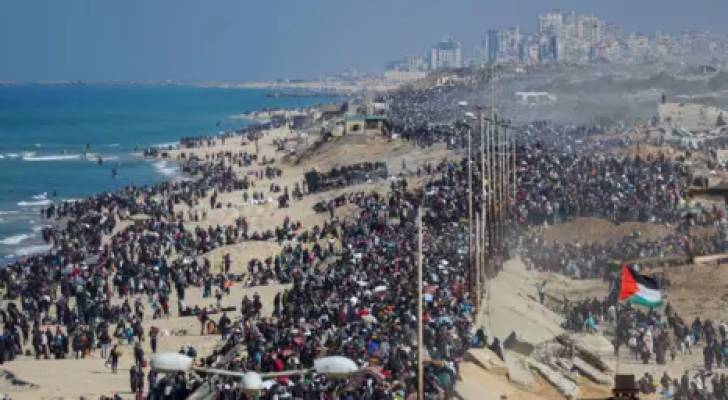Palestinians displaced by "Israel" head toward north Gaza in an attempt to return to their homes on Jan. 27, 2025. (Photo: Reuters)
Returning to northern Gaza: Witnessing survival amid destruction
“I was lost in what was once Jabalia”
Mohammed Ashour, a 52-year-old Palestinian man from Gaza, was forced to flee his home in the Jabalia camp when the “Israeli” aggression began in October 2023.
In an effort to keep his family—his wife, daughter, two sons, and two grandchildren—safe, he traveled south to what was believed to be a secure area in the Gaza Strip.
.png)
However, on Jan. 27, after nearly 15 months of displacement, Ashour made the decision to return home. He walked 12 kilometers back to Jabalia, against his family’s advice to wait longer. What he found was nothing like what he had hoped for.
Tens of thousands of displaced Palestinians began returning to northern Gaza after “Israel” reopened a corridor into the area, though two days later than initially scheduled— a delay they blamed Hamas for.
Within the first week of reopening, more than 300,000 displaced Palestinians had returned to northern Gaza, according to the Government Media Office in Gaza.
Many had waited for weeks for this moment, spending days sitting in the streets or on the beach with their mattresses, belongings, and water tanks, anxiously awaiting the checkpoint’s reopening.
But for Ashour, returning home was not the reunion he had dreamed of.
“I was lost in what was once Jabalia,” he said. “My longing for Jabalia camp echoes the poet's words: ‘I will return, running to the land, to embrace its red soil. The peach trees call me, along with the apricots and apples.’”
Yet when he returned, there was nothing left. “Even the birds in the sky had abandoned Jabalia Camp,” he said. “All that remains are memories.”
.png)
Asem Alnabih, spokesperson for the North Gaza Governorate, spoke to Roya about the dire situation in the northern region: “The situation is extremely dire, with a severe shortage of basic necessities, especially water.”
He noted that 60 percent of the city’s total area lacks access to clean water and added, “There is also a significant accumulation of waste and sewage leaks, creating an environmental and health crisis that jeopardizes citizens' safety.”
The damage to infrastructure is widespread, Alnabih said, with 75 percent of water wells affected and over 1,000 meters of the water network severely damaged in Gaza City.
“The suffering has persisted even with the ceasefire in place. There is an urgent need for assistance,” he stated. “So far, there has been no meaningful or effective intervention from international organizations.”
As for Ashour, he went back to Khan Yunis, where he searched for a house to rent, but his son Mohammed stayed in Jabalia, where he set up a tent on the remains of his family’s house.
Mohammed understood that his father needed to return south to look after the rest of the family, but he preferred to live in a tent where his house once stood.
.png)
.png)
Ismail Al-Thawabteh, the director-general of the Gaza Media Office, spoke to Roya about the challenges faced by those returning to the north and said that a small number of people have returned south due to the harsh living conditions they faced in the north.
However, this group is relatively small in number and doesn't represent the majority.
Al-Thawabteh added that the resilience of the people of Gaza is what has ultimately defeated the displacement plans put forth by the Occupation.
“While some might think that the people of Gaza are incapable of rebuilding, they are mistaken. Today, many are setting up tents on the rubble of their homes in northern Gaza, refusing to give in to any efforts to displace them.” Al-Thawabteh added.
Ashour, despite the overwhelming destruction, is still planning to return to Jabalia, whenever that may be in the future. His determination to rebuild his home and his community remains steadfast, just like so many others in Gaza.




